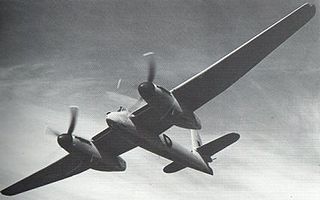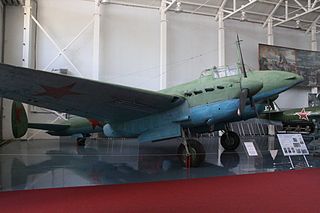
The Westland Welkin was a British twin-engine heavy fighter from the Westland Aircraft Company, designed to fight at extremely high altitudes, in the stratosphere; the word welkin meaning "the vault of heaven" or the upper atmosphere. First conceived in 1940, the plane was built in response to the arrival of modified Junkers Ju 86P bombers flying reconnaissance missions, which suggested the Luftwaffe might attempt to re-open the bombing of England from high altitude. Construction was from 1942 to 1943. The threat never materialised; consequently, Westland produced only a small number of Welkins and few of these flew.

The Junkers Ju 388Störtebeker is a World War II German Luftwaffe multi-role aircraft based on the Ju 88 airframe by way of the Ju 188. It differed from its predecessors in being intended for high altitude operation, with design features such as a pressurized cockpit for its crew. The Ju 388 was introduced very late in the war, and production problems along with the deteriorating war conditions meant that few were built.

The Junkers Ju 188 "Rächer" ("Avenger") was a German Luftwaffe high-performance medium bomber built during World War II, the planned follow-up to the Ju 88 with better performance and payload. It was produced only in limited numbers, due both to the presence of improved versions of the Ju 88, as well as the increasingly effective Allied strategic bombing campaign against German industry and the resulting focus on fighter production.

Junkers Flugzeug- und Motorenwerke AG more commonly Junkers, was a major German aircraft and aircraft engine manufacturer. It was founded in Dessau, Germany, in 1895 by Hugo Junkers, initially manufacturing boilers and radiators. During World War I and following the war, the company became famous for its pioneering all-metal aircraft. During World War II the company produced the German air force's planes, as well as piston and jet aircraft engines, albeit in the absence of its founder who had been removed by the Nazis in 1934.

The Dornier Do 217 was a bomber used by the German Luftwaffe during World War II as a more powerful development of the Dornier Do 17, known as the Fliegender Bleistift. Designed in 1937 and 1938 as a heavy bomber but not meant to be capable of the longer-range missions envisioned for the larger Heinkel He 177, the Do 217's design was refined during 1939 and production began in late 1940. It entered service in early 1941 and by the beginning of 1942 was available in significant numbers.

The Messerschmitt Me 264 was a long-range strategic bomber developed during World War II for the German Luftwaffe as its main strategic bomber. The design was later selected as Messerschmitt's competitor in the Reichsluftfahrtministerium's Amerikabomber programme, for a strategic bomber capable of attacking New York City from bases in France or the Azores.

The Junkers Ju 287 was a multi-engine tactical jet bomber built in Nazi Germany in 1944. It featured a novel forward-swept wing, and the first two prototypes were among the very few jet propelled aircraft ever built with fixed landing gear.

The Junkers Ju 89 was a heavy bomber designed for the Luftwaffe prior to World War II. Two prototypes were constructed, but the project was abandoned without the aircraft entering production. Elements of its design were incorporated into later Junkers aircraft.

The Junkers Ju 290 was a large four-engine long-range transport and maritime patrol aircraft designed and produced by the German aircraft manufacturer Junkers.

The Petlyakov Pe-2 was a Soviet twin-engine dive bomber used during World War II. One of the outstanding tactical attack aircraft of the war, it also proved successful as a heavy fighter, as a night fighter and as a reconnaissance aircraft. The Pe-2 was, numerically, the most important Soviet bomber of World War II, at their peak comprising 75% of the Soviet twin-engine bomber force. The Soviets manufactured Pe-2s in greater numbers during the war than any other twin-engine combat aircraft except for the German Junkers Ju 88 and the British Vickers Wellington. Several communist air forces flew the type after the war, when it became known by the NATO reporting name Buck.

The Junkers Ju 86 was a monoplane bomber and civilian airliner designed and produced by the German aircraft manufacturer Junkers.

The Henschel Hs 127 was a German bomber that was built as two prototypes, but cancelled without entering mass production.

The Junkers Ju 288, originally known within the Junkers firm as the EF 074, was a German bomber project designed during World War II, which only ever flew in prototype form. The first aircraft flew on 29 November 1940; 22 development aircraft were eventually produced.

The Focke-Wulf Fw 191 was a prototype German bomber of World War II, as the Focke-Wulf firm's entry for the Bomber B advanced medium bomber design competition. Two versions were intended to be produced, a twin-engine version using the Junkers Jumo 222 engine and a four-engine variant which was to have used the smaller Daimler-Benz DB 605 engine. The project was eventually abandoned due to technical difficulties with the engines.

The Vickers Windsor was a Second World War British four-engine heavy bomber, intended for high altitude flight. The Windsor was designed by Barnes Wallis and Rex Pierson at the Vickers-Armstrongs factory at Brooklands.

The Henschel Hs 130 was a German high-altitude reconnaissance and bomber aircraft developed in World War II. It suffered from various mechanical faults and was never used operationally, only existing as prototype airframes.

The SNCAC NC.150 was a prototype French high-altitude bomber aircraft designed and flown just prior to the start of the Second World War. It was a twin-engined monoplane, with a third engine driving a supercharger. Although testing was promising, and orders were planned for a modified version as a back-up for the Lioré et Olivier LeO 45 and Amiot 354 bombers, the surrender of France in June 1940 ended development with only the single example being built.
The Messerschmitt P.1107 was a jet-powered bomber project developed in the final years of the Second World War.

















